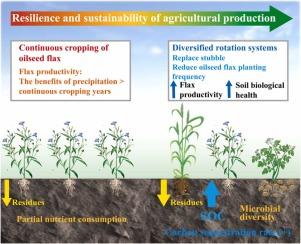Diversifying crop rotation improves productivity of oilseed flax by increasing soil carbon sequestration and soil biological health
IF 6.2
1区 农林科学
Q1 AGRICULTURAL ENGINEERING
引用次数: 0
Abstract
Diversified crop rotations are proposed to enhance agricultural system productivity, stability, and climate resilience. Oilseed flax, a crucial oilseed crop in rain-fed agricultural systems of China, faces increasing challenges under climate change due to conventional monoculture practices. Therefore, our eight-year field experiment in northwest China's rain-fed region assessed how integrating potato and wheat into flax monoculture affects oilseed flax productivity and soil health. The research results revealed that: In initial years, diversified rotation increased oilseed flax productivity and soil carbon sequestration, with minor positive effects on soil bacterial communities. As rotations progressed, these benefits amplified due to accumulated system functionality and increased precipitation. The wheat → potato → wheat → oilseed flax (WPWF) treatment achieved the maximum average grain yield of oilseed flax (70.2 % increase) and sustainable yield index (SYI, 63.9 % increase) over two crop rotation cycles, alongside a lower coefficient of variation (CV), compared with continuous oilseed flax monoculture (Cont F). Notably, soil carbon sequestration and bacterial diversity correlated positively with the oilseed flax productivity. Overall, soil organic carbon (SOC) storage under the crop rotation systems increased by 8.4 %−19.9 % and 10.7 %−30.7 %, respectively, compared with the Cont F in 2016 and 2020. Through integrated comprehensive evaluation and economic benefits analysis, the WFPF and WPWF systems are validated as regionally optimal rotations. It provides farmers with flexible implementation options to select context-adapted sequences based on local conditions. This study highlights diversified crop rotations as essential for long-term food security, soil health and farmers' income growth.

作物轮作多样化通过增加土壤固碳和土壤生物健康来提高油籽亚麻的生产力
提出了多样化的作物轮作,以提高农业系统的生产力、稳定性和气候适应能力。油籽亚麻是中国雨养农业系统中重要的油籽作物,由于传统的单一栽培方式,在气候变化下面临越来越大的挑战。因此,我们在中国西北雨养地区进行了为期8年的田间试验,评估了马铃薯和小麦与亚麻单作结合对油籽亚麻生产力和土壤健康的影响。研究结果表明:在最初几年,多样化轮作增加了油籽亚麻的生产力和土壤固碳量,对土壤细菌群落的积极影响较小;随着轮换的进行,由于系统功能的积累和降水的增加,这些好处被放大了。小麦→马铃薯→小麦→油籽亚麻(WPWF)处理与连续单作油籽亚麻相比,在两个轮作周期内油籽亚麻平均产量(提高70.2 %)和可持续产量指数(SYI,提高63.9 %)最高,变异系数(CV)较低(对照F)。土壤固碳和细菌多样性与油籽亚麻产量呈显著正相关。总体而言,2016年和2020年轮作制度下土壤有机碳(SOC)储量分别比同期增加8.4 % ~ 19.9 %和10.7 % ~ 30.7 %。通过综合评价和经济效益分析,验证了WFPF和WPWF系统是区域最优轮换。它为农民提供了灵活的实施方案,以根据当地情况选择适合环境的序列。这项研究强调,多样化的作物轮作对长期粮食安全、土壤健康和农民收入增长至关重要。
本文章由计算机程序翻译,如有差异,请以英文原文为准。
求助全文
约1分钟内获得全文
求助全文
来源期刊

Industrial Crops and Products
农林科学-农业工程
CiteScore
9.50
自引率
8.50%
发文量
1518
审稿时长
43 days
期刊介绍:
Industrial Crops and Products is an International Journal publishing academic and industrial research on industrial (defined as non-food/non-feed) crops and products. Papers concern both crop-oriented and bio-based materials from crops-oriented research, and should be of interest to an international audience, hypothesis driven, and where comparisons are made statistics performed.
 求助内容:
求助内容: 应助结果提醒方式:
应助结果提醒方式:


